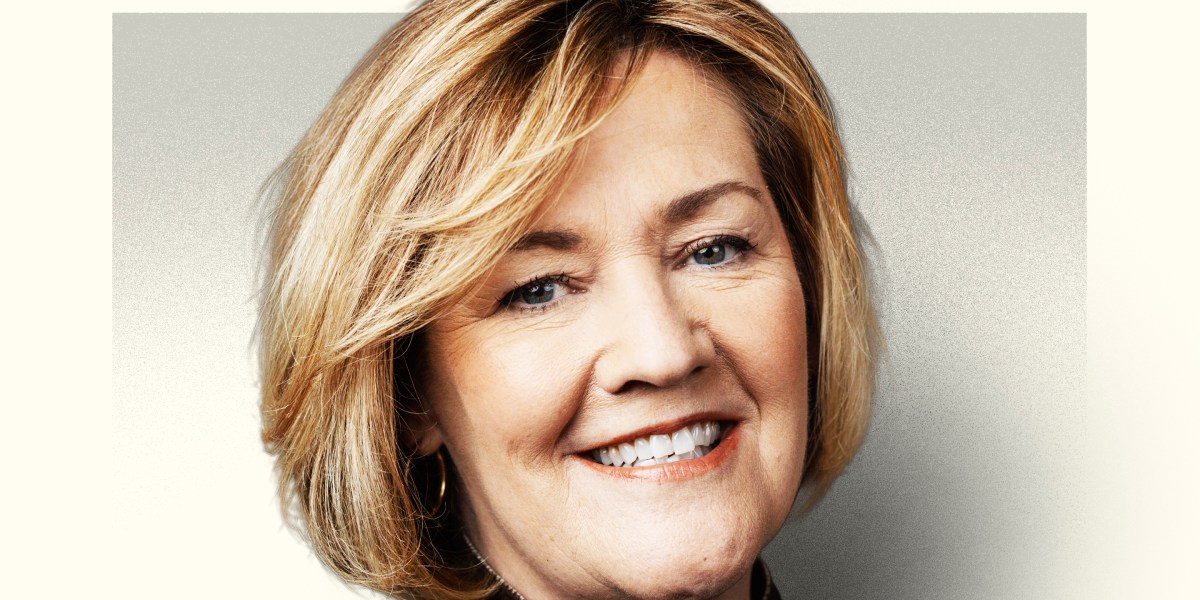New Delhi: Usman Khawaja is expected to receive a formal notice from Cricket Australia after bluntly labelling the Perth Stadium surface for the first Ashes Test a “piece of s**t” during a charity lunch this week.
According to reports, CA…

New Delhi: Usman Khawaja is expected to receive a formal notice from Cricket Australia after bluntly labelling the Perth Stadium surface for the first Ashes Test a “piece of s**t” during a charity lunch this week.
According to reports, CA…


Streaming platforms are the winner of Black Friday 2025, and this deal for Peacock is sweet.
This deal gets you a discounted Peacock subscription…

Adaire Fox-Martin understands the needs of Big Tech. Prior to becoming CEO of Equinix (No. 446 on the Fortune 500) last year, she held senior roles at Google, SAP and Oracle. Now, the Irish-born former teacher is driving the expansion of the world’s largest global data center network, with more than 273 data centers in 36 countries. Fox-Martin recently spoke with Fortune about what she learned in her first year in the job and where she wants to go from here.
This interview has been edited and condensed for clarity.
We last met when you were starting out in the role.
It’s been an incredible year of learning and realizing that this job doesn’t come with an instruction manual. You bring the experiences that you’ve had in the past to the decisions that you make for the company for the future. We’ve laid out the strategy and optimized it into 10 simple words. The first of those is “build bolder.” which is how we’re designing and constructing the infrastructure that underpins the digital economy.
The second part of our ten-word strategy is “solve smarter.” This is about how we abstract the complexity of networking and architecture, which is our secret sauce, and render that for our customers, making Equinix the Easy button. The third piece is to “serve better.” Most participants in the data center industry have five or six customers; we have more than 10,000 enterprise customers. So those are the three pillars.
What are the other four words?
Underpinning that, we have “run simpler,” which sounds easy to say and is very hard to do. You’re taking complexity out of your business, looking at systems and processes. And the last piece is our people piece, which is to “grow together,” growing our business with our customers, linking our employee success to our customer success.
Is that a big change?
Equinix has been a company in this segment for 27 years, so we’re one of the long-term players in this industry. And in the next five years, we’re planning to bring on as much capacity as we did in the last 27 years. That’s a big capital investment for us.
Where do you sit in the data-center ecosystem?
I think there’s a general trend to think of data centers as a homogeneous mass of a singular thing. But there are four distinct categories of data centers, and each one has its own nuance and characteristics. We exist in one of those categories. There’s the hyperscale category, the ones built by cloud-service providers, where you see massive investment. The second category is wholesale, where you’re usually building a facility to lease back to one tenant, maybe two, usually supporting (AI) training. The third is enterprise, where big companies like banks want to have their own center structure. And the fourth category is colocation, which is where Equinix sits.
And what are the advantages of that?
Think of us a little like an airport authority. It manages the runaways and the facilities of the airport and gives you the ability to rent ticketing and other kind of facilities in there. Then it manages the process of passenger engagement, so an airline comes in, like KLM, drops a passenger, and then magic happens in the background to move that passenger and their luggage to United to go on to California. We’re a little bit like the airport authority of the internet: a data package comes into Equinix and then moves on to where its next destination is. The difference between us and an airport authority is that the airport lines will compete whereas a lot of our customers colocate so they can collaborate.
What do you do in terms of AI workloads?
We do both training and inference. A pharmaceutical company would do their training privately at Equinix because in the pharma world much of their research and drug discovery processes have to go through private models for regulatory reasons or intellectual property protection. Training is like teaching the model and then inference really putting what the model has learned to work.
What about the energy needs?
The different types of data centers have different characteristics when it comes to energy, who they’re starving, or how they’re supporting local economies and communities.
We’re smack bang in the middle of what I would describe as an energy super cycle. Data centers are one component of it, but so is the electrification of everything. You have the speed of an AI meeting the pace of utilities, and it’s a headfirst collision. We don’t think it’s an insurmountable challenge but it’s going to require collaboration, innovation and time.
How do you seeing it playing out?
Between now and 2028, it’s fair to say there is a power crunch. Anything that we’re delivering until 2028, we understand where our power will come from. From 2028 to 2032, you’ll see an innovation click into the power landscape, in the form of data centers and data center operators looking at how they can self-generate, how they can generate on site, how they can innovate with the grid, and give power back to the grid, how they can be flexible on and off the grid. You’ll see different aspects of innovation, including nuclear, looking at small modular reactors and how they can be utilized.
From 2032 on, the utilities have introduced some changes. In the past, you would go to a utility and say, ‘I want this much here in this time, just-in-time power provision.’ For someone like us, which doesn’t have the same power draw as a hyperscale data center, that was usually good enough. But utilities are looking at their power framework in the form of cluster studies, taking a group of requirements together in a cluster at the same time. You define the load that you’re going to ramp up to and it will likely take the form of take or pay. If you said you’re going to use this much, you will pay for it, whether you use it or not.
It’s important that large energy users, like data centers, pay a premium for what they’re utilizing so that we don’t impact small ratepayers, small energy users, so there’s a lot happening around collaboration. We’ve got a 27-year history of that kind of collaboration with the utilities and so we’re very involved in a number of those processes.
Talk about the challenge of building these centers.
One is supply chain, the things that are needed to construct a data center, some of which have been subject to tariffs. In the short term, that’s not an issue but longer term, that may become something that we have to navigate our way through. And then there’s the workforce, the plumbers and mechanical engineers and welders who are maintaining our environments that keep the internet up. A lot of trade skills, construction skills and technical skills are necessary to create the data center.
Are the centers you’re building for these workloads any larger than the ones that you built in the past?
We do support our hyperscaler partners with the provision of data centers, through a vehicle called xScale, which is a joint venture. We have partners who fund our joint ventures, so we do participate in what I described as the wholesale economy by building what’s called a build-to-suit data center industry for a hyperscaler. So a Google would come to us and say, ‘do you guys have power and land in location X? And would you build for us?’ So we do that through a joint venture off our balance sheet because the capital-intensive nature of that is high. We own 25% of our America JV and we own 20% of our EMEA and our APAC JV. We have 15 centers that are already operational around the globe.
What do you think is underappreciated about your business model?
I think the connectivity of Equinix is underappreciated. We have 270 data centers around the world, so we’re the world’s largest independent data center operator that’s still a public company. People see the physical manifestations of those centers, but the secret sauce is the connections that sit in every single one of those data centers. They take three forms. First is the ability to interconnect a company to another company. We have the trading hubs: 72% of the world’s trading platforms operate on Equinix. You have a trading hub and all their partners located closely to them that need to be literally connected so there’s no latency between the transactions. We have 492,000 deep interconnections between the companies that operate in our centers, between value chains.
The second piece of connectivity is to do with the clouds. They are an exceptionally important part of the technology landscape. Many customers store their data in clouds and most customers store their data in more than one cloud. They spread the love. We have a 35% market share in native cloud on ramps from our data centers. So you can pop into the cloud, get your data and bring it back.
And then the third piece is physically where we’re located. We’re not in the middle of the country. We are in cities, where human beings are with their devices. So many people refer to us as the metro edge, the city edge, the edge where people actually are. So we can connect the cloud, via the metro edge where humans are, to the far edge where devices might be utilized.
Do you think people appreciate the role that data centers play in their lives?
In many countries, we are designated as critical infrastructure, in certain states, too, but not at the federal level. When I think about moving home: water, gas, electricity, internet becomes that fourth utility. And 95% of internet traffic runs through the Equinix environment. If you were on a Zoom call this morning, if you did a stream from any of the major providers, ordered an Uber, purchased a train ticket, you were on a platform accessing Equinix at some point.
“95% of internet traffic runs through the Equinix environment.”Adaire Fox-Martin, CEO, Equinix
What are you seeing in terms of customer trends?
Many of our customers are moving from the proof-of-concept phase of AI into the real-world-application phase of AI. There’s a lot to grapple with in that. It isn’t just about taking a business process and putting AI over the top of it. There are a whole series of considerations around governance and the management of data that haven’t really played into the business picture yet that are very real, especially for industries that are highly regulated.
That’s why some have not even adopted that much AI.
Right. Even if they are frontrunners, now it’s kind of like coming back and saying, ‘oh, how do we make sure that we’re audible, traceable, accountable, all of the things that are good governance for business. If we’re going to deploy a technology that can automate so many things and take my human out of the loop, how do I report, manage, and maintain the governance framework of those processes in my business?
We’re seeing a lot of pushback in local communities where these mega hyperscale data centers are being built. How are you staking your claim to say we’re not that, but this is still critical infrastructure we need?
You look at it through the lens of what are the good things that a data center can do for a local community. We engage very strongly with local communities when we are beginning a construction. You do bring jobs to the area, particularly in the construction face, less so when you’re in the operation face because there isn’t a preponderance of humans across a data center. Second, you’re obviously going to pay tax in that location and that has knock-on benefit. Thirdly, we employ and source locally. I’m very excited about our apprenticeship scheme, where young women and men who maybe didn’t have a formal education path can become data-center technicians or critical facility engineers. And when there’s a build of a data center, there’s often an upgrade of the infrastructure around it, like whether that’s the power capabilities, the roads and so on.
Are people asking more questions about water, energy?
For sure. And we recognize that these are extremely important parts of the life system of our planet. We were the first data center operator to begin reporting on our water usage. When you bring in power, you want to maximize the use of that energy in the deployment of workloads for customers and not just empowering the data center itself. We measure our power and how effective we are in using power. The best way to save energy to use less of it. That’s absolutely an industry standard now.
And water?
Water was never at the same level of investigation or scrutiny as power was. Now, there’s a measure of water-usage effectiveness and we were one of the first to report on that. It’s not as standardized as power and so we’re working in the industry to try and standardize that a little bit more.
In the longer term, data centers will more than likely be cooled by liquid cooling, as opposed to air or evaporative cooling. And liquid cooling, in terms of water use, is a closed-use-loop system. You’re reusing the same water over and over again to cool the chips. The technology itself will become a determinant of sustainability.
All the big tech companies are working to make these models smaller and more efficient. Eventually, they’re going to want to have many little data centers that are colocated. Do you think you’ll benefit from that?
We believe the inference target addressable market, combined with the network, is about $250 billion outside of what the clouds are doing. By 2029, the inference opportunity will be twice the size of training. And that’s why we’re setting ourselves up for this opportunity.
You can think about training as a centralized AI emotion whereas inference is very much a distributed emotion. It will initiate on a device or maybe through voice, or glass, 0r whatever the device is. And it will probably have an agent conduct its orchestra, in terms of instructing other agents to get data from more than one location. That’s why we’ve been very selective about where we built.
You came to this job from Google almost a year and a half ago. Where are you now versus what you were thinking when you came in?
I would say on a journey, not at the destination but heading in the right direction. I’m confident that we have such a unique combination of characteristics—the metro locations, the connectivity, the secret sauce—that we’re ready for prime time. I’m working through the dynamics of some of the negative feelings around data centers. The challenge around energy has been very real in Europe, in particular. There are countries that have just issued a moratorium on data-center builds, like Ireland, my home country, until they can kind of take a breath and understand whether they can do. These problems are absolutely addressable. They’re absolutely surmountable. It’s a time-based issue that’s going to require collaboration and innovation to solve.
What about the regulatory environment? That’s been in flux.
There is a lot of noise on a variety of topics. I’m just working to control the controllable, and carry on the path that we believe for us is the right path. For example, Equinix has some goals around our sustainability narrative. By 2030, we set a goal for ourselves that we would be neutral as it relates to the use of carbon. We’re still on that track. And we’ve set a science-based goal for 2040 to be net zero and we will continue to innovate and work to do that.
It’s not just that we believe there is an opportunity for technology and innovation to exist with good environmental stewardship. Our customers are continuing to ask us for reports on how their usage at Equinix is impacting things that we may be measure.
There’s a lot of what about AI. What will it do? But there’s a where about AI. And we’re like the where of AI. There are physical cables, even under the ocean, and cable trays and billions of wires. If you’re in California, you get to see the history of data centers. The internet will literally be above your head. We have three decades of data center history, from our very first one to our latest one. I never thought I would come into a company where we have 56 active construction projects all around the world.

The $1 trillion pay package for CEO Elon Musk that Teslashareholders approved on Nov. 6—the world’s first—was labeled by the board as an exemplar of pay for performance. And at first glance, the program appears to fit that description in a big way: The hurdles it establishes for Musk to receive any compensation at all, let alone achieve the maximum 13-digit payout, appear the ultimate in stretch goals. Skeptical observers might wonder: “How could anyone be motivated by targets this seemingly unachievable?”
On the other hand, Tesla loyalists and the three-quarters of Wall Street analysts issuing either a “buy” or “hold” on the EV maker praise the arrangement’s similarity to one from 2018 that spurred Musk to work wonders—at least in boosting the share price. Now, they’re positing: “Elon’s already done it once. Now he’ll be super-motivated to stay in the job and conjure a second miracle. And if that happens, stockholders will pocket another king’s ransom.” Musk concurs.
A close examination of the new plan, however, reveals that it harbors a “betwixt and between” problem. The lower-hanging fruit are too easy to harvest, and the harder goals that would mark substantial and genuine progress in profitability too difficult to attain. Probable outcome: Musk gets nothing resembling the $1 trillion, but still pockets one of the biggest payoffs in corporate America—as shareholders suffer along the way.
The reason the epic scheme risks backfiring: It contains two loopholes that enable Musk to fare handsomely by doing something he’s great at, hyping the stock via making big promises, then delivering just enough on the basic business end to clinch a rich reward.
The package consists of 12 tiered grants of restricted stock. Unlocking each “performance milestone” requires reaching both a valuation and an operational goal. It’s the safety deposit model: You need two keys to open the box. The market cap triggers start at $2 trillion and ascend by increments of $500 billion to the summit of $8.5 trillion, a number that’s 70% bigger than the $5 trillion that Nvidia recently notched to reign as the world’s most valuable company. The second group of keys are the “operational milestones.” Four cover sales for key products: separate, cumulative targets for deliveries of vehicles and “bots,” chiefly humanoid robots, as well as for robotaxis in commercial operation and subscriptions for full self-driving software. The other eight are Ebitda tiers that start at $50 billion, and max at $400 billion.
Put simply, anytime Musk hits a new valuation goal, and also captures any one of the dozen operational targets in any order, he receives 35.312 million shares in Tesla restricted stock, adding roughly 1% to his current stake of almost 16%.
The stunner that grabbed headlines, of course, is the $1 trillion in stock—424 million shares—Musk would receive for taking the market cap to $8.5 trillion, and also clinching all 12 of the operational objectives. Musk’s got 10 years to make the numbers that trigger the grants. The “earned share” tranches have two vesting periods: early 2033 for those achieved in the first five years, and late 2035, or at the end of the decade-long program, for the ones reached in years 6 through 10. On the Q3 earnings call, Musk repeatedly insisted that he needs to reach an ownership percentage in “the mid-20s” to ensure “enough voting controls to give a strong influence.” He effectively praised the board for handing him the opportunity to get there, and apparently thinks he stands a great chance at sweeping the board. That coup would get Musk where he wants to go by raising his stake to about 28%.
In reality, Musk faces low odds of garnering any of the higher targets. Let’s start with the operational side. Hitting almost all but one of them would require moonshots. For example, the robotaxi target requires achieving an active fleet of 1 million. Today, Tesla offers only an extremely limited pilot plan in Austin, and Waymo, the industry’s largest player, has only 2,000 of the vehicles on the road. And the easiest Ebitda level stands at a towering $50 billion. Ringing the bell would likely require multiplying its current Ebitda run rate around fivefold. Yet Tesla’s now going in the wrong direction by booking puny and declining profits. Reversing that downward trend to reach even the minimum profitability mandated in the operational milestones can only happen if its unproven products prove wildly successful in highly competitive, and capital-intensive sectors.
Now to the valuation milestones. Tesla’s stock already appears vastly overpriced. Its current multiple, based on “core” earnings from its auto and battery businesses of just $3.6 billion in the past four quarters, excluding such items as sales of regulatory credits, towers at 375. Hitting the second highest valuation mark of $2.5 trillion alone would require an 85% jump in its stock price. Huge progress that’s not happening is already baked into the valuation, making the chances of huge, sustained gains from here remote, though a Musk-orchestrated, ephemeral surge can always happen.
Though Musk probably can’t scale the mountain, he may be able to mount the foothills.
He stands a decent chance of scoring both the lowest valuation number of $2 trillion, and the least challenging operational tier—selling a cumulative total of 20 million vehicles, starting from the time of the grant. On the first item, the surge in Tesla stock since the board unveiled the program in early September has already pushed the price from $334 to $408, lifting its valuation from $1.12 trillion to $1.35 trillion—and the package gives Musk credit for that increase. So if Musk can boost the shares another 48% to $2 trillion, he’ll check the initial box for market cap. The rules require that the shares average $2 trillion or above for six months, and separately for the last 30 days, to hit the target.
It could easily happen. Musk has proved a master at sending the shares skyward by promising great things in robotaxis, full self-driving (FSD), and robots, even though he hasn’t yet significantly commercialized any of them. More promises could breed more excitement that could breed another speculative frenzy in Tesla shares centered on great expectations.
The operational part that’s reachable, especially over a longer period, is the goal of selling 20 million vehicles. This provision invites close scrutiny. According to the plan’s requirements contained in an SEC filing dated Sept. 5, this target doesn’t start from zero at the time the package takes effect. It’s a cumulative total over the entire history of Tesla. Here’s the wording: “20 Million Tesla Vehicles Delivered: Expanding Tesla’s vehicle fleet from 8 million EVs, which it has currently, to 20 million will further grow its adjusted Ebitda, allowing Tesla to reinvest in its other up-and-coming product lines.” Hence, since Tesla has already sold 8 million cars, it only has to deliver 12 million for Musk to capture that operational hurdle.
It’s an incredibly weak requirement, and one of the two wrinkles that aids Musk and skewers shareholders. In the past four quarters, Tesla has delivered 1.9 million cars, and Musk is pledging to expand the lineup to encompass a new affordable EV, and sell self-driving cars to customers. If it averages 2 million cars a year, Tesla would achieve the 12 million figure by the end of year six. Hence, Musk would clinch an operational target by achieving only a minimal annual increase in Tesla’s vehicle sales.
Here’s the second softball pitched by the board. If Musk manages to get the market cap to $2 trillion or above, and keep it there for six months, he’s turned that key definitively. No going back. No matter what happens to the share price after that, he’s got that bogey in his pocket. As Tesla’s SEC filing detailing the plan states, “Once a Market Capitalization Milestone or any particular Operational Milestone is achieved, it is forever deemed achieved for purposes of the eligibility of the Tranches to become Earned Shares.”
So let’s say Musk is able to notch the $2 trillion target in six years. Then the shares bounce around, going above and below that level, so that by the end of the 10-year grant period in late 2035—by which time he’s added the 20 million vehicles prize—its cap is $1.95 trillion, or $585 a share. In other words, Musk could talk up the shares, then see them pretty much go sideways for years, and they could even head below the price that unlocked the award.
Fortunately for shareholders, the stock grants come with a feature similar to equity options that somewhat reduces Musk’s payday, especially in a case like the one above where the plan flops. Musk only gets the gain over the stock price at the time of the grant—in other words, just the appreciation. He’d receive the first tranche of shares at a “net” of $251 per share, that’s the $585 at the end of the 10-year vesting period minus the effective “strike” price of $334 (the price when the program was conceived in September). Hence, he’d pocket $8.86 billion in one stroke (the equivalent of 35.3 million shares x $251).
That would be all of his compensation for 10 years of running Tesla. To be sure, he’d wait a long time for the money, and it isn’t anywhere near the trillion he apparently believes is feasible. But it’s still big, averaging almost $90 million a year. By comparison, in their respective fiscal years, Sundar Pichai earned $10.7 million, Mark Zuckerberg $27.2 million, Jensen Huang $34 million, Jamie Dimon $39 million, Andy Jassy $40 million, Tim Cook $75 million, and Satya Nadella $79 million.
What about the shareholders? Taking the shares from $334 to $585 in 10 years represents paltry gains of just 5.9% annually. That’s a lousy deal for Tesla’s shareholders. They’re suffering at the same time Musk is en route to getting a windfall of nearly $900 million.
Say Tesla’s shares do even worse and end the 10-year grant period at a market cap of $1.8 trillion, $200 billion below the goal of $2 trillion that Musk achieved at one point but couldn’t increase or even hold on to. Shareholders would get returns barely beating inflation, and Musk would still get a payout of $727 million.
To complicate matters, it’s likely that failing to collect on any of the other, extremely challenging tranches will prove a downer for Musk. In our scenario, he’d only increase his stake in Tesla by 1% when his goal is a rise of over 10 points. Musk would have a strong incentive to stay the full 10 years for the haul waiting at the end. But an unhappy Musk might mean a less-than-fully-motivated Musk. This package could hammer shareholders while they witness the decline of the idol it’s designed to empower.

It’s easy to overlook the Black Friday subscription deals available each year when you’re focused on getting physical things for yourself and others. But it would be a mistake to do so since you can often save a ton on subscriptions and services…

If there’s one type of Black Friday sale you can rely on, it’s the deals on laptops and computers.
While more fashionable tech appliances like the Nintendo Switch 2 or iPhone 17 Pro get smaller deals – they don’t need to worry about demand after…

Heart rhythms and pace give critical insights into cardiovascular health. The rhythms of your heartbeat can reveal a lot, even warn you about your conditions. Just like how irregular heartbeats indicate conditions like arrhythmia. Just like…


HONG KONG — It was just after 3 p.m. when William Li received the unusual call from his wife, who was at work, saying she’d heard from a friend that their building was on fire.
There were no alarms, no signs of smoke in his 2nd floor apartment,…